Picture Prompts – Creating Art Journal Pages with Hand-Drawn Animals
This week, we use small collage pieces as picture prompts for art journal pages.
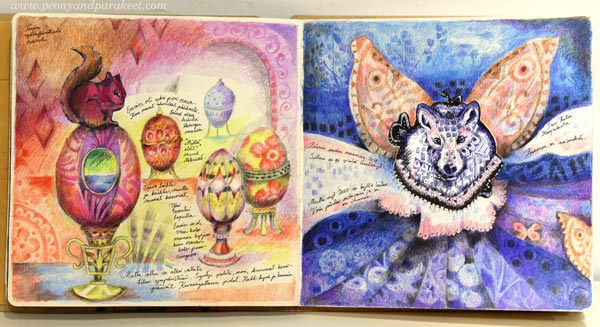
First you pick a small image, a hand-drawn squirrel or wolf in my case, and use that as inspiration for the rest of the page. You will need paper, colored pencils, and a pen for journaling. I also used felt-tip pens for the details that I wanted to highlight and graphite pencils for quick sketching. I attached the animals to the page with double-sided tape. My journal is Dylusions Creative Journal Square. (Affiliate link to Amazon.com).
Open Your Box of Joy and Select the Animal!
We will use hand-drawn animals as picture prompts. You can, of course, use any image, but I suggest starting with animals.
I save my hand-drawn collage pieces in boxes that I call boxes of joy. These little drawings are born from the joy of drawing. I have cut them so that they can be used as collage pieces.
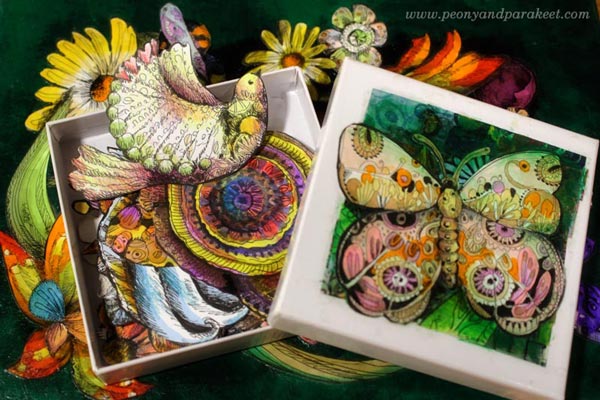
I started drawing these small separate little things in 2018, and have been creating them ever since. It’s so easy to pick a paper scrap and draw something simple, and then get enthusiastic about adding decorations and colors to it. I have several online courses where we draw these: Animal Inkdom, Magical Inkdom, Decodashery, and Doll World.
My animals are mostly drawn for the courses Animal Inkdom and Magical Inkdom, and I love them so much, that I have also printed copies of some of them. I have many boxes to choose from and I love to both use them and re-fill them.
For the first page, I selected a squirrel because it has pink and orange, and those have been my favorite colors recently.
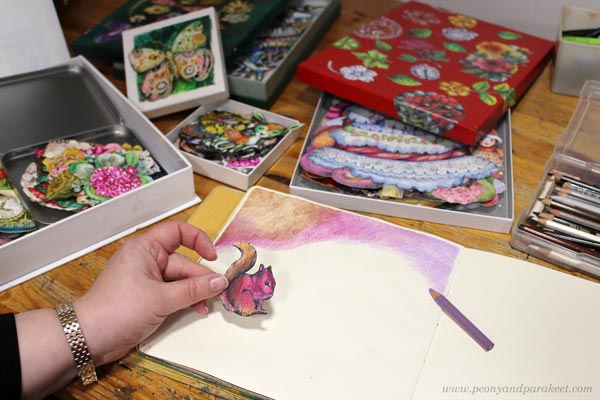
After selecting the animal, use its colors to color a small part of the page! Just color some layers freely (like in the course Intuitive Coloring). Don’t glue the animal yet, wait until you draw more and the story unfolds.
Picture Prompts – Go Beyond the Obvious!
We have a big nut bush in our garden and squirrels love it. So, my first thought was to draw some nuts for the squirrel. But that would be too ordinary and not fun at all. What if this squirrel would chase after Faberge eggs while others collect peanuts?
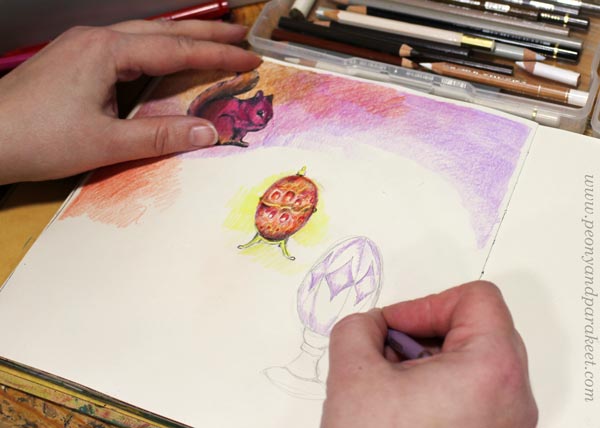
I love drawing decorated eggs. In Doll World, we draw a big egg, but this time I wanted the eggs to be small so I could fit many on one page.
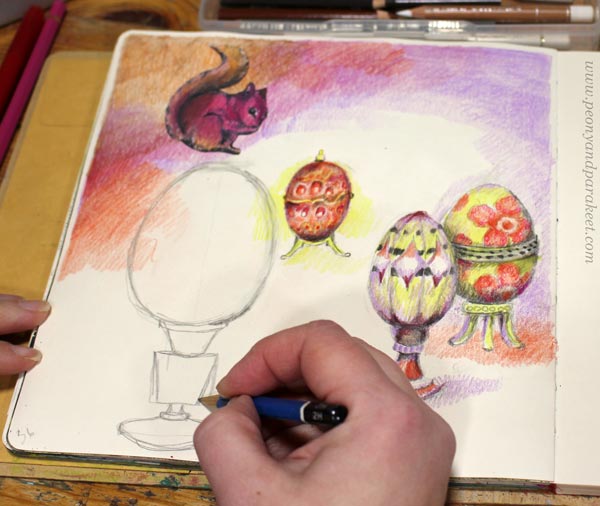
I made the eggs a bit different in size to make the page more interesting.
Static vs. “What If …”
When using the animal as a creative picture prompt, you want to find the story – not only the connection between the starting idea and the additions but also something surprising that keeps the inspiration going. If you only draw the ordinary, the picture easily becomes static – nothing is happening. Go for the extraordinary! Change the rules of reality, change the roles of the objects, make the animal speak – by drawing, you can create a world of your own. Ask: “What if?”
When I drew the first egg, it felt like just any object, but when I drew more of them, my imagination started working. Maybe the squirrel could sit on the biggest egg? And maybe the eggs could have a bigger role than to be just a decoration.

What if the scenery that I colored inside the biggest egg would leak into the surroundings?
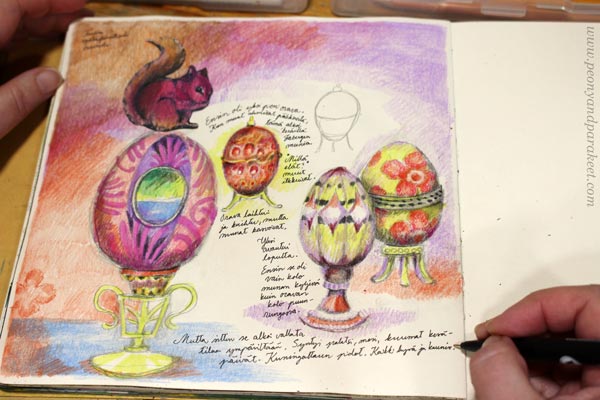
I wrote: “A palace was born, hot summer days came here, the queen (the squirrel) had a party, and all things good and beautiful came up.”
Then I drew more and completed the page inspired by the journaling.
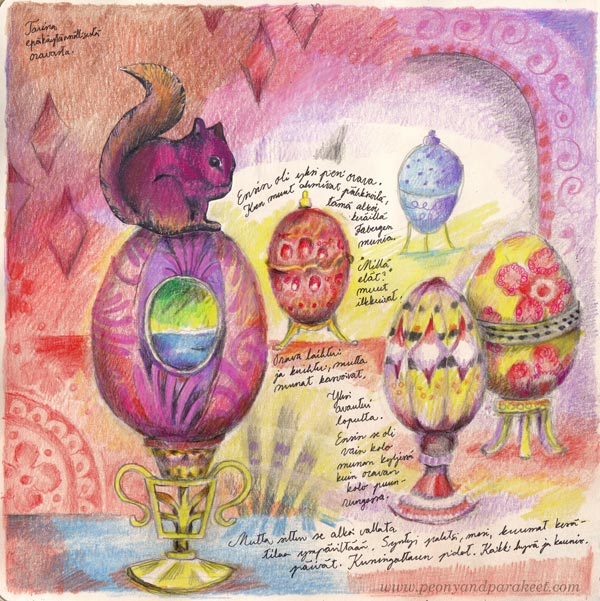
This is a story about an impractical squirrel who collected Faberge eggs instead of nuts and wasn’t much like other squirrels. But her eggs didn’t stay small. They grew and opened and created a place for her to live in.
“Isn’t that a story about every artist,” I realized after the page was finished.
Flying Wolf Art Journal Page
Let’s pick another animal and make the second page!
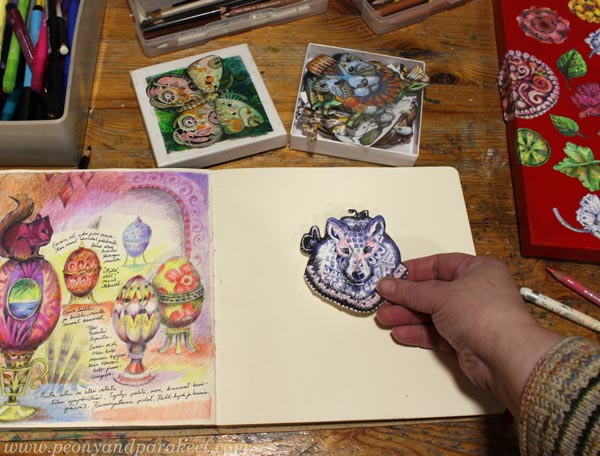
This wolf is the first little collage piece that I drew in 2018, so it’s time to give her a home. Decorating the animals was one of my core ideas for Animal Inkdom, so I can now color freely so that the decorations will continue to the background too.
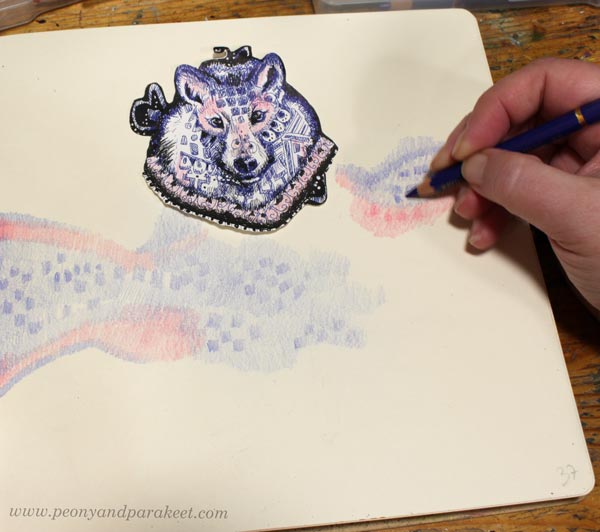
Again, I am using the colors that the animal has: blue, black, and pink. This way the collage piece doesn’t look separate from the rest of the page.
I wanted the wolf to fly, but not with furry wings. Could the wolf be partly a butterfly?
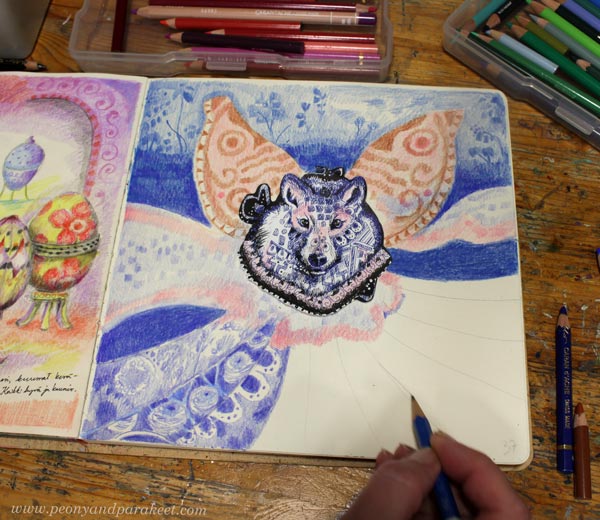
With the wolf, I felt a connection to my North Karelian origin. With the butterfly wings, I celebrated being a woman and loving delicate beautiful things.
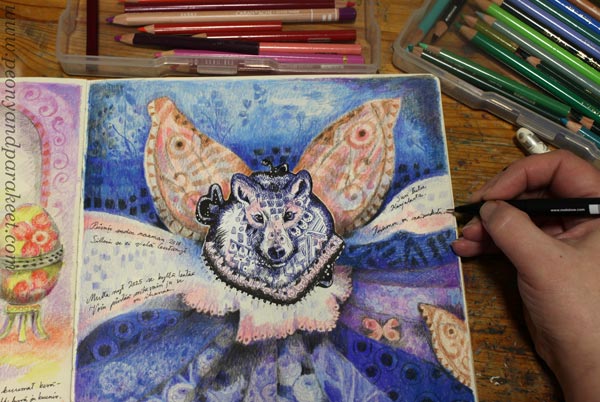
This wolf didn’t feel like a lonely one. So, I added a small butterfly and another bigger that is showing only partly on the right edge.
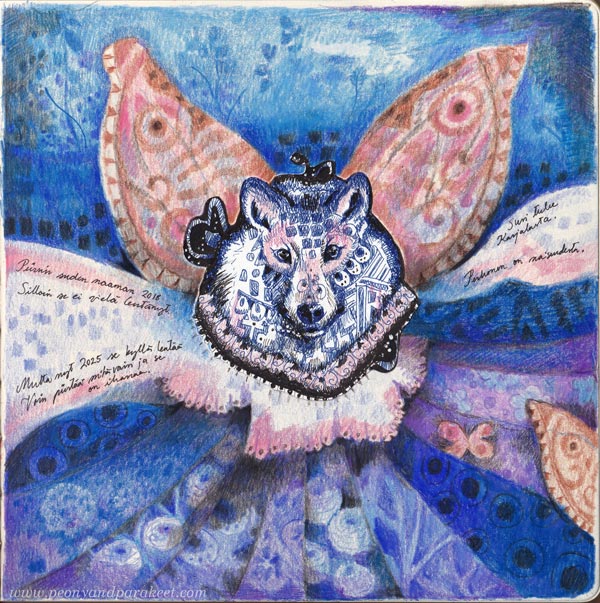
Back in 2018, my wolf didn’t fly yet, but it’s flying now! The more you draw, the more you can imagine!
Picture Prompts – Step by Step
- Pick the animal.
- Use the animal’s colors and patterns to get started.
- Ask: “What if …”
- Answer by drawing and journaling.
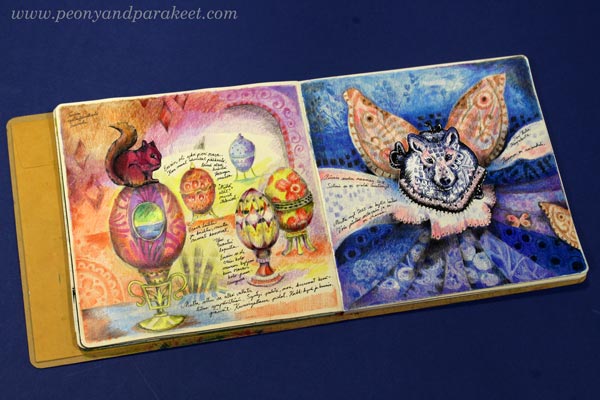
New in Development!
I have been making a new course that has a working title “Hearts and Stories.” I have already drawn quite many pieces for it. I collect them under a plastic plate that fits the side table of my studio. There I can see the whole collection at the same time, and think about what’s missing and how I will proceeed.
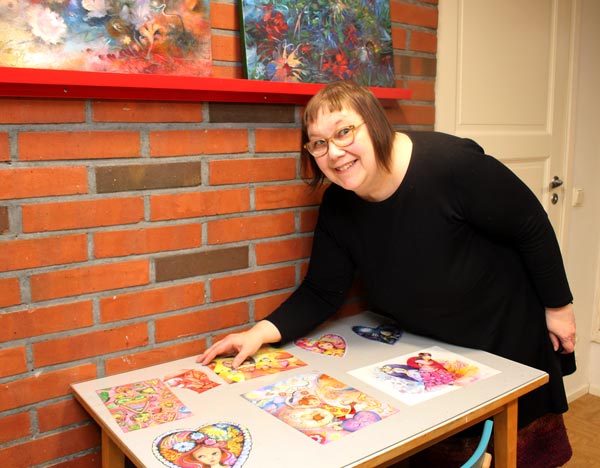
These drawings make me smile. My goal is that you too will smile when the course is running!
I want to be the advocate for drawing, because:
- If you only think, your imagination has limited capacity.
- If you only paint, you will stop playing and eventually run out of creative ideas.
- Drawing is important for any artist and for any human being.
What do you think?
Black Art Journal Pages as Banners
I want my Black Friday campaigns to be inspiring for art-making, and this year my theme is “Black Berry Friday.” It means juicy art journal pages on black paper. I am pretty sure you have one like my black and square Dylusions Creative Journal (affiliate link).
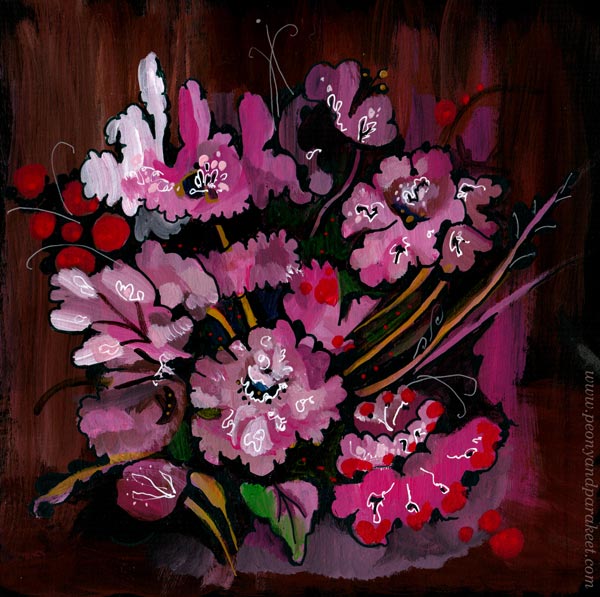
I use my black art journal for using up old supplies that don’t inspire me anymore. And if I have leftover paint on a palette, I make a few brush strokes on a page rather than toss the paint away. This floral page was born from those kinds of careless strokes and now, much later, I finished it with paint markers.
Edges and Banners
Usually, the center of the page is the most important area, but for banners, the edges need to draw attention. Here, the circular floral design, enhances the center text area beautifully.
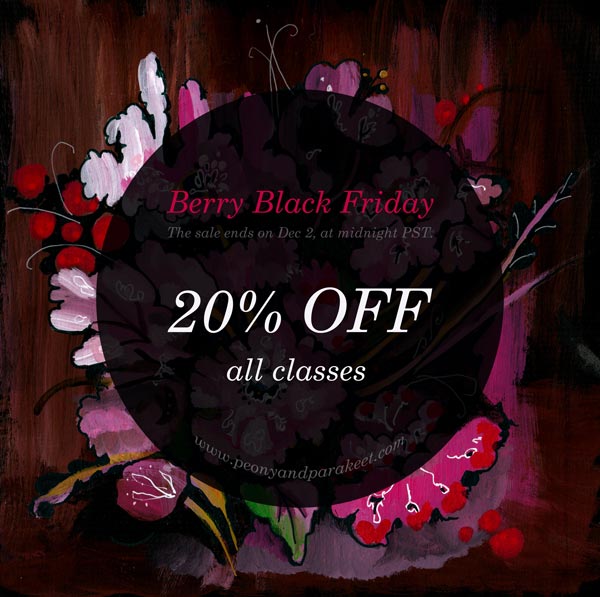
I made the banner in Photoshop, and boosted the colors a bit.
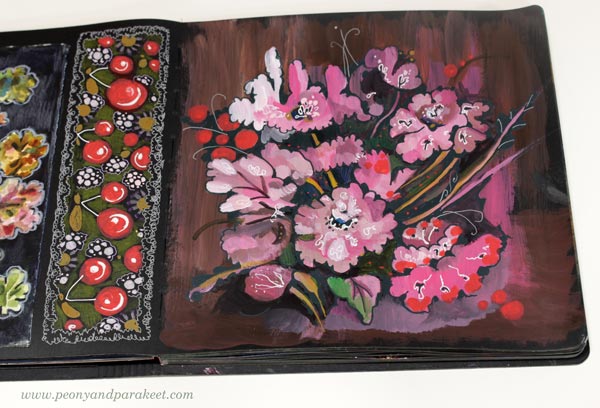
I also drew a long rectangle of cherries that not only makes a great banner but also looks great on the journal. I think we treat art journal pages too often as one unit when a page could be divided in sections and thus bring more variation to the journal.

My banner wasn’t long enough for all the purposes, so I made it longer by duplicating the design in Photoshop.

Colored Pencils on Black Art Journal Pages
I like to use colored pencils with paint markers. Marker pens produce thick and opaque shapes but colored pencils are softer and more translucent. Colored pencils are great for backgrounds. Look at these stripes!
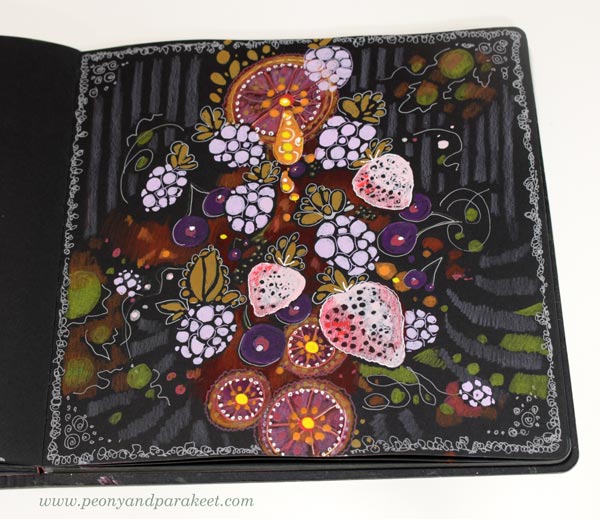
I also used gel pens to add thin lines.
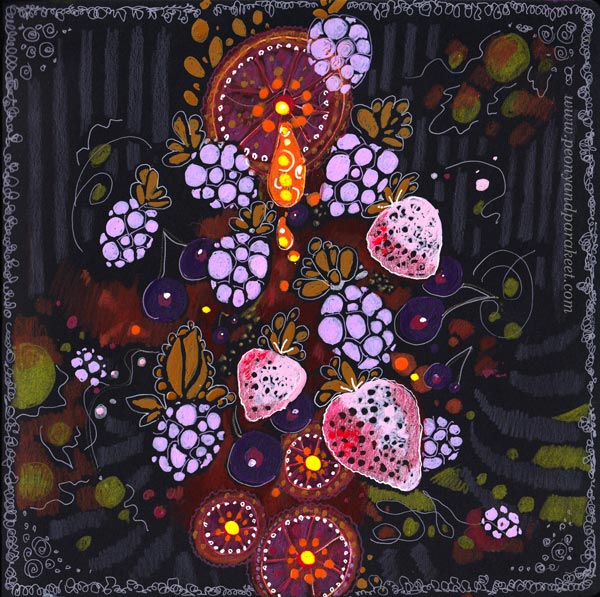
Again, I became more interested in the background than the center. The center is not very elegant, but here, in the banner you mostly see the edges.
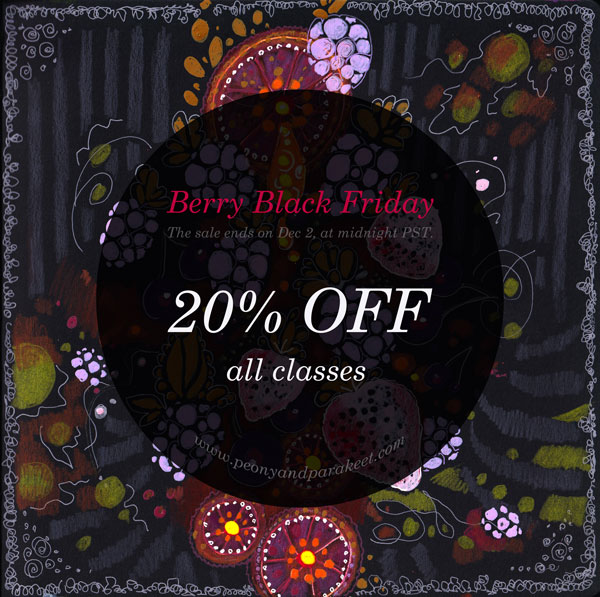
Doodling on Black Art Journal Pages
My Black Friday offer is simple: All classes are 20% OFF. So I wanted the banners have some simplicity too. Doodling circles is easy and doesn’t require much thinking.
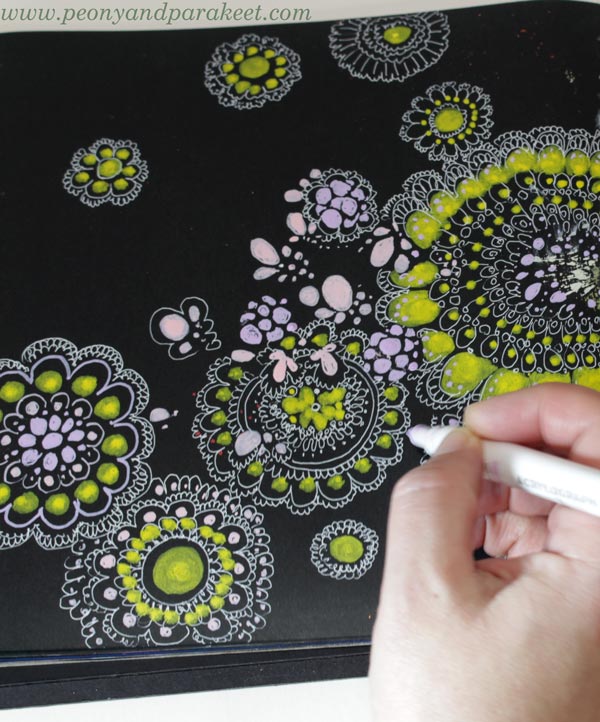
I got a bit carried away though!
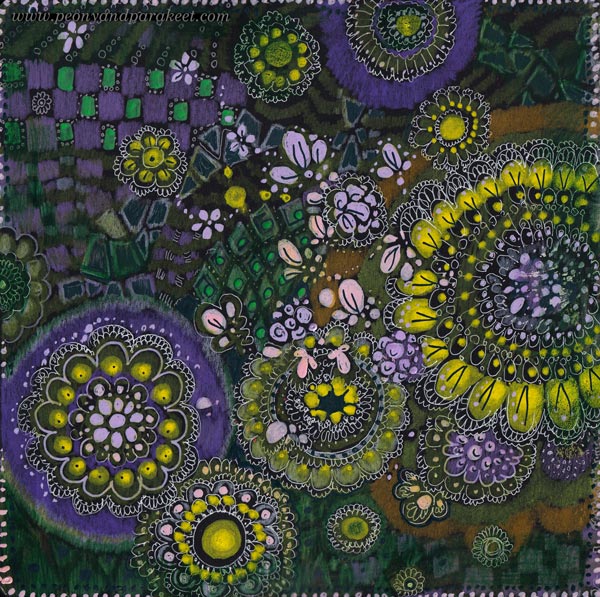
I was talking on the phone and watching a movie while doodling, and once I stopped, I thought that I doodled too much. But the banner looks great and of course, there can’t be too much of anything in art!
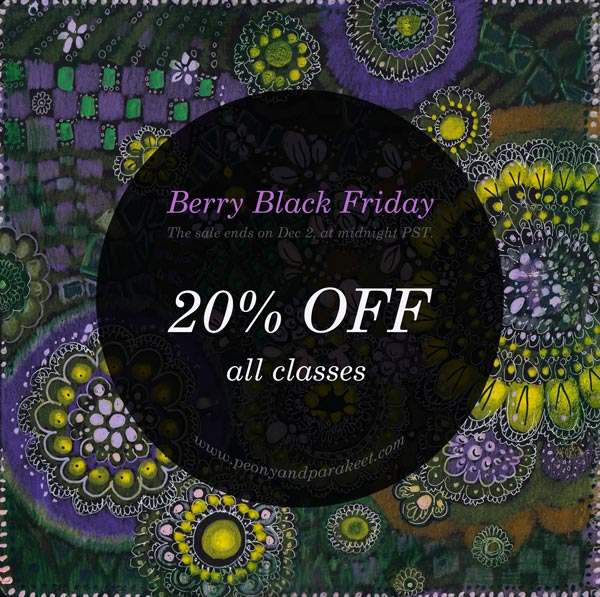
Designs for Fabric
I got so inspired making these pages, that I had to play with Photoshop a bit more than necessary. I combined many pages into one design and I think something like this would make a great fabric.
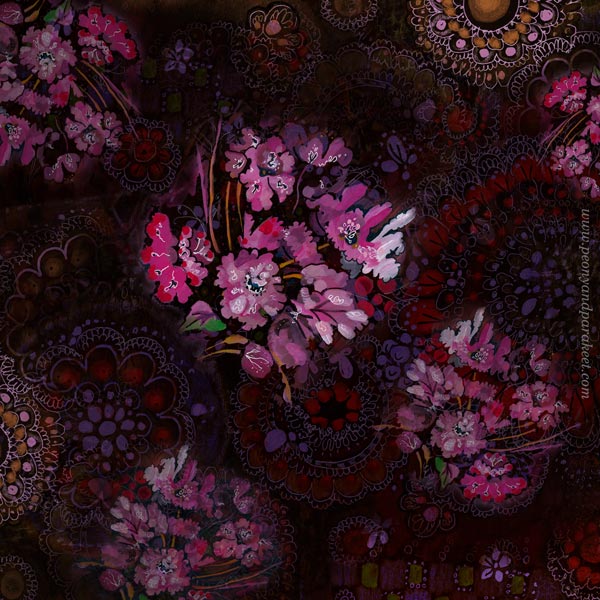
Black Over Painted Background
I have been contemplating whether I should use both sides of the pages on my black art journal. Using only one side would give a blank page to protect the art on the opposite page. But the journal looks much more inspiring when both pages are covered!
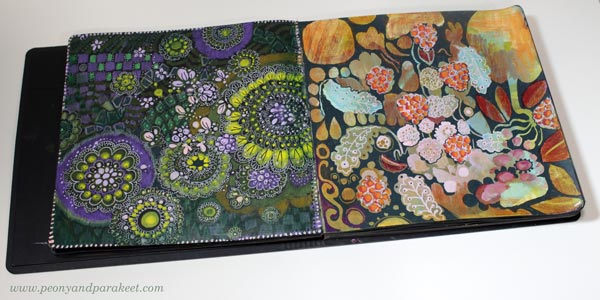
Here’s one more idea for an art journal page, and this works on any journal. When you have painted backgrounds, use dark marker or paint on top to make shapes from the background.
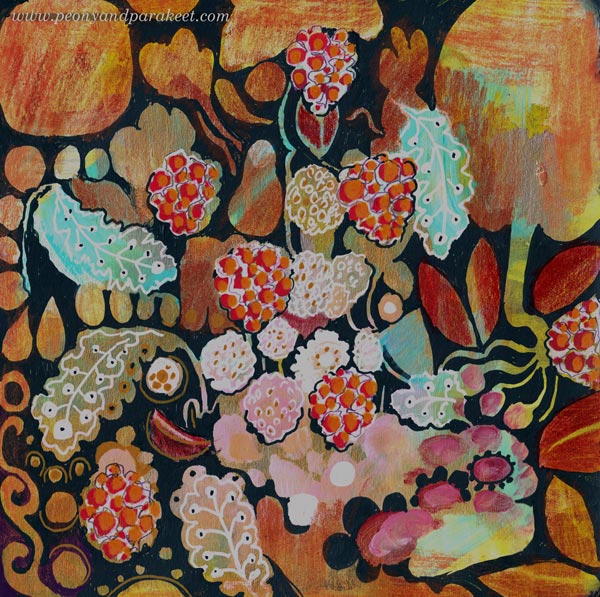
I wanted to make one banner that has fall and thanksgiving themes with berries. The page became a bit busy, but again, the banner is ok, I think!
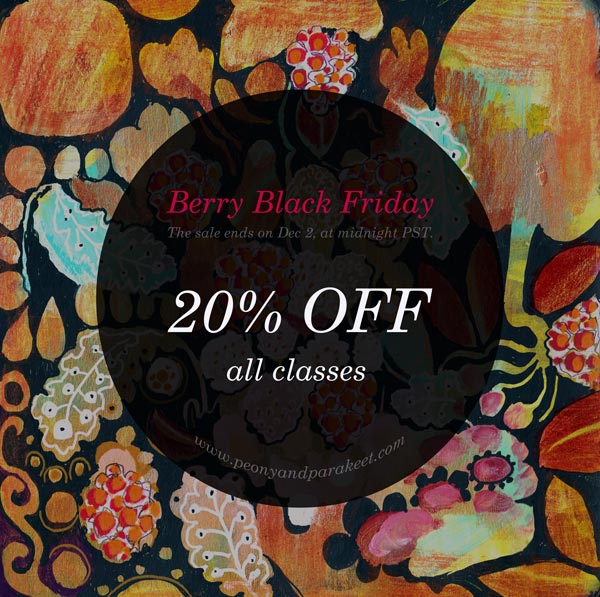
And now: it’s time to shop the sale!
The Black Berry Friday sale ends on Dec 2, 2024, at midnight PST.
5 Tips for Quick Abstract Flowers
This week, we paint quick abstract flowers freely without any references.
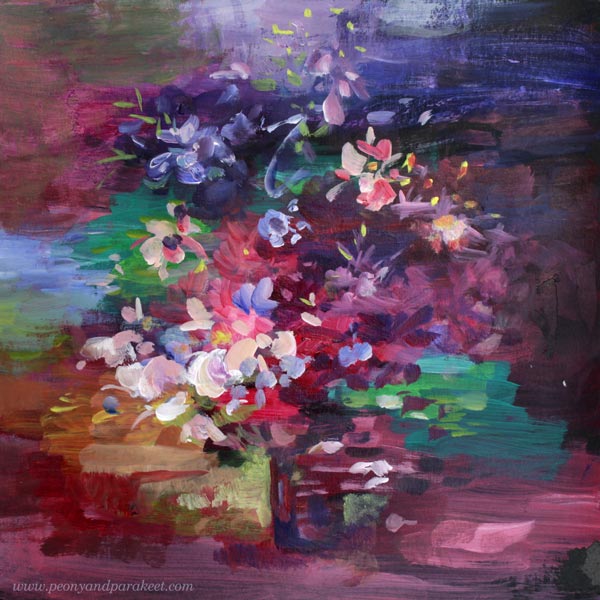
I have a black Dylusions Creative Journal and make small paintings there occasionally. It is especially good when there’s still paint left on the palette at the end of the painting session. I think it makes sense to use all the paint, and not throw the leftovers in the trash.
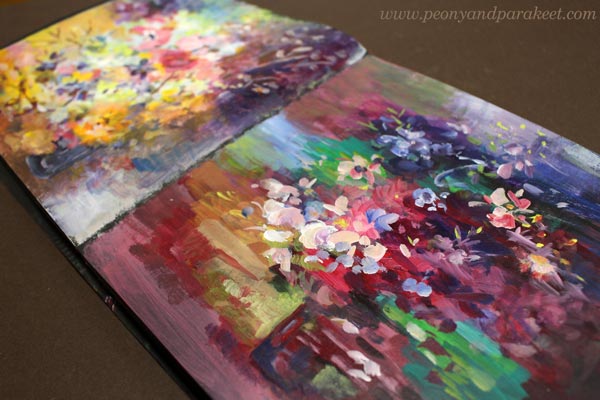
I don’t use any gesso but paint directly on the page.
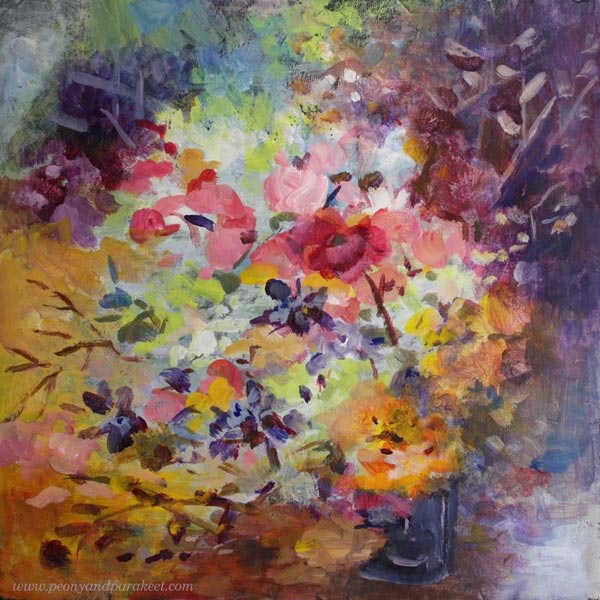
When I painted pieces for the course Liberated Artist Revisited, I noticed that there had been a long break in acrylic painting and some of the tubes had started to harden.
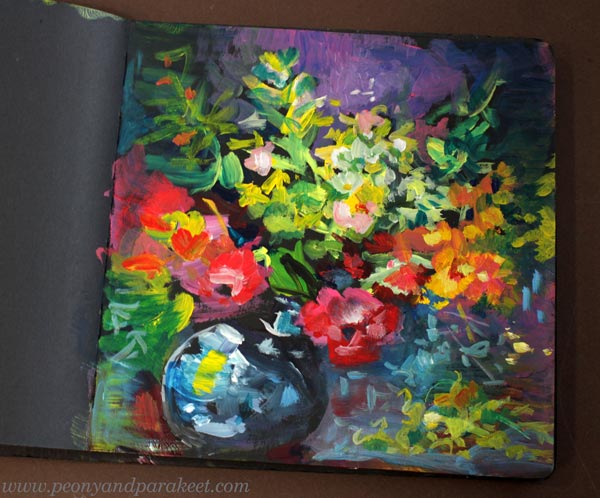
It motivates me to paint in the black art journal again because I don’t want those paints to go to waste. And sometimes it’s nice to paint something small quickly and see what comes out most effortlessly.
Quick Abstract Flowers – Five Tips!
I like painting abstract flowers, and thick paints are very suitable for abstract flower paintings. Here are my five tips for painting flowers quickly.
1) Start from the Old Mess
The fastest way is to start from an old painting.
I have a lot of pages in my journal where I’ve hastily painted shapes with leftover paints.
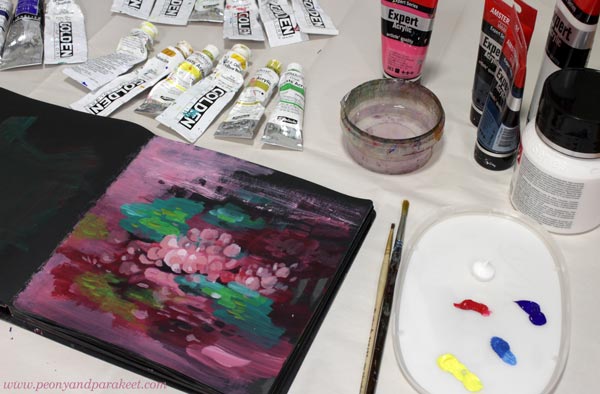
Continuing the beautiful mess feels much more effortless than starting a new one from the beginning.
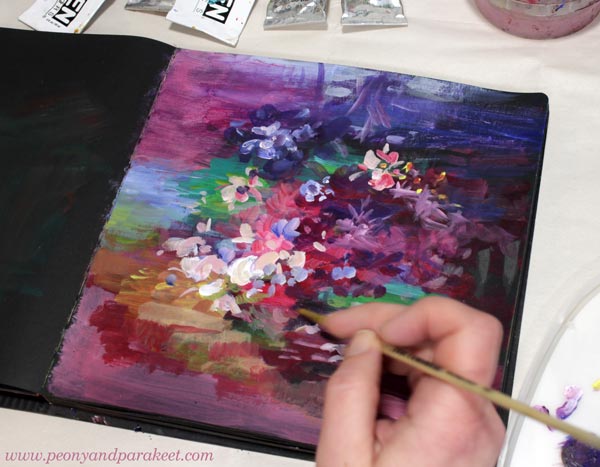
For example, here’s one page that still waits its turn to become a finished painting.
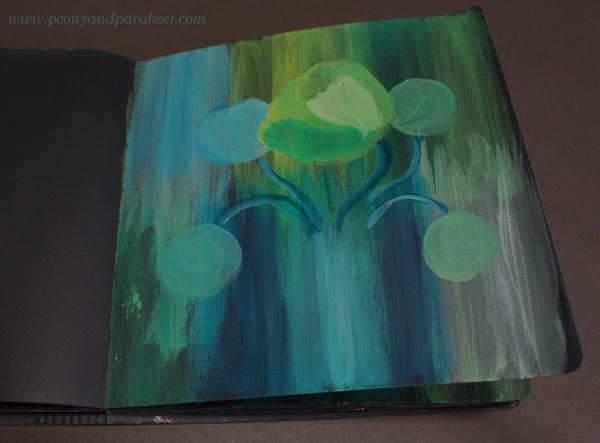
Most of my beginning messes are much more messy though!
2) Dark-Bright-Light
Include all three degrees of darkness in one painting.
Make color mixes and compare them in terms of darkness. By including all three – dark, bright, and light – you can achieve depth and atmosphere.
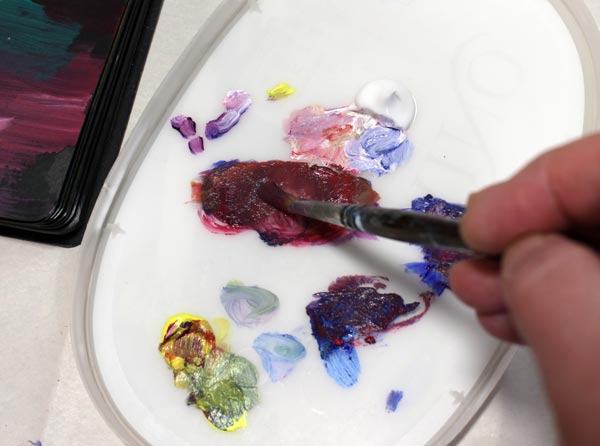
Make clear larger areas so that you can point to different places in the background and say, there is dark, there is bright, and there is light.
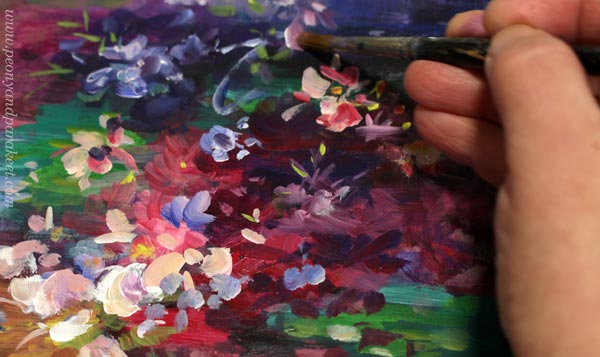
Flowers can have all three – dark, bright, and light colors.
3) Forget the Real Flowers!
Don’t think too much about the real flowers.
Don’t think about what a rose looks like or what flowers you want in your painting. All that stiffens your expression.
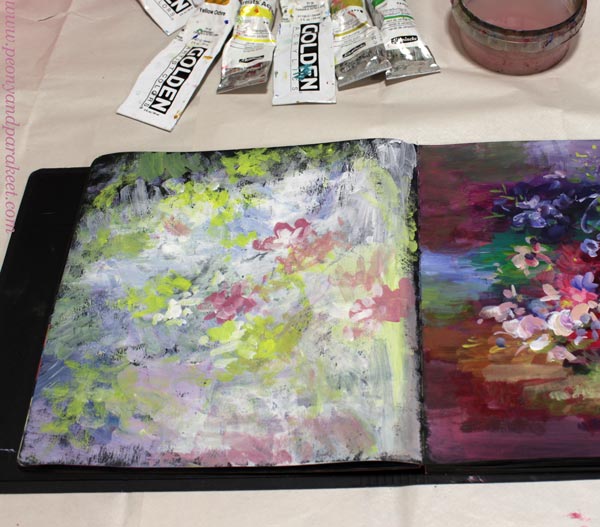
Focus on the colors and let the flowers form from the brushstrokes.
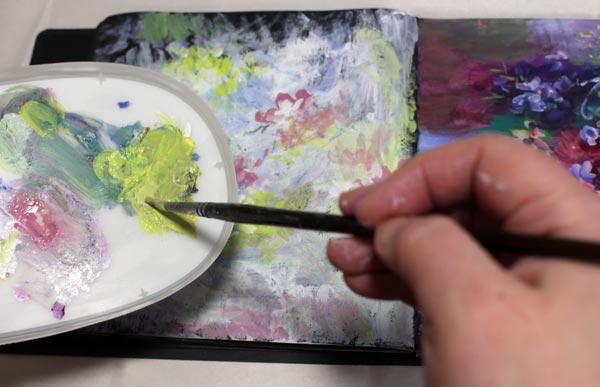
After all, a flower is just a few colorful strokes and a line for the stem.
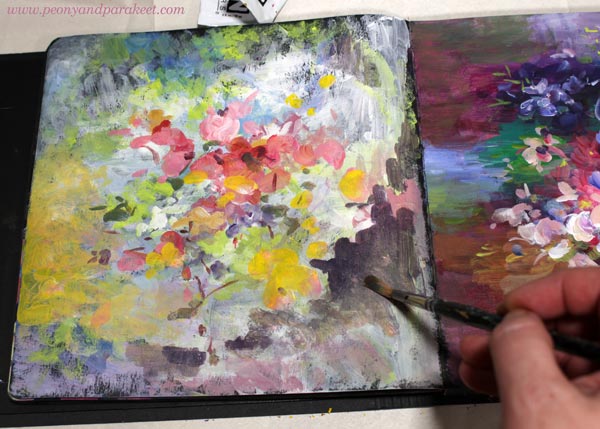
Use your imagination when you look at your work in progress!
4) Leave Room for Spirit
Not everything needs to be defined or look like a flower.
Flowers are concrete matter, so let the colors express the spirit!
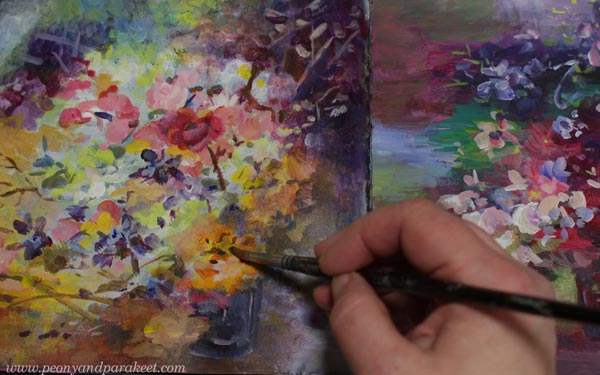
If you want to be extra quick, sharpen just one flower near the center and leave the others more abstract and vague.
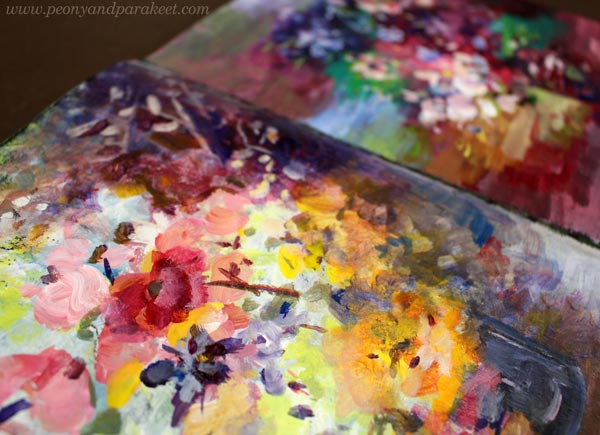
5) No Forced Feelings
Open yourself up to an emotional experience.
The speed of the painting depends highly on how soon you get an emotional connection with yourself and what you are doing. Let even the darkest thoughts come. For creativity, everything genuine is equally good.
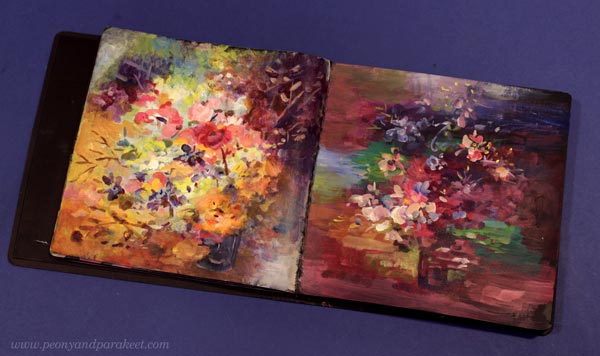
The beauty of making art is that imagination creates abundance and eternal life from almost nothing – from the leftover paint and leftover energy. And the more often you create, the more you get out of it!
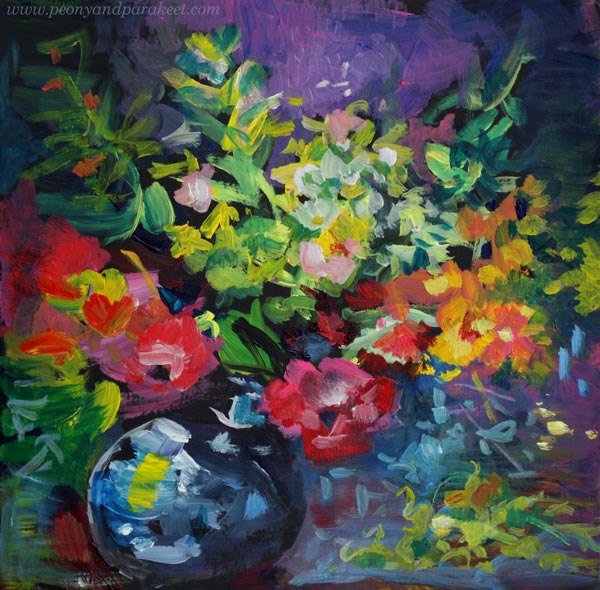
Liberated Artist Revisited – Buy Now!
In Liberated Artist Revisited, we time-travel to meet the teacher – Paivi from 2015, and create new art with her.
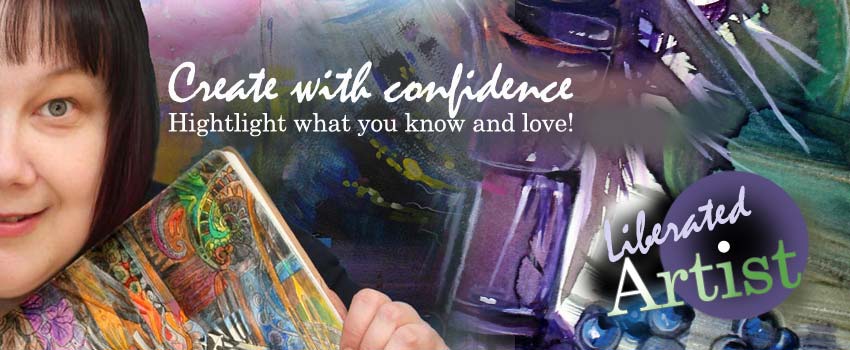
This course is both for the left and right brain. The young Paivi gives systematic instructions while the older Paivi enjoys her freedom and ponders about art-making and life in general.
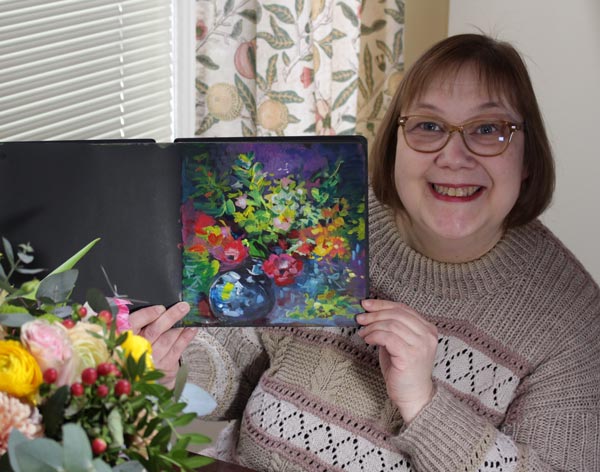
Liberated Artist Revisited is a limited edition – only available for purchase until the end of March 2024! >> Buy Now!
Inspiring Art Journals
This week is dedicated to inspiring art journals that hopefully make you start creating right away.
Towards the end of last year, I started to really miss drawing. When I want to come up with ideas, I need a pen and paper! Or maybe I should say that I need my art journals because that’s where the ideas stay in good order.
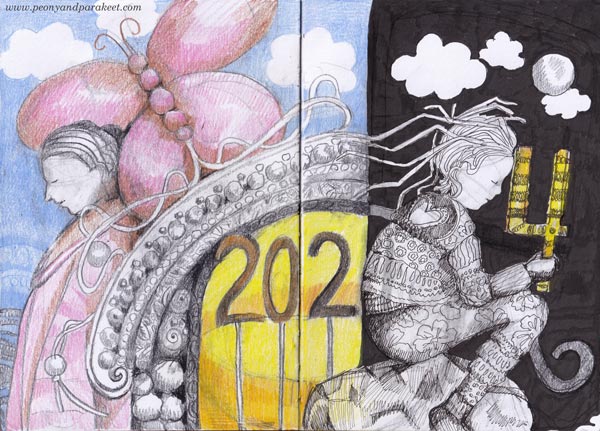
I made this spread in my colored pencil journal. 2023 is an old romantic woman that is going away and a young girl who is ready for adventure will take her place.
There are only a few pages after the previous year’s spread.

I hope to make more pages in this colored pencil journal this year.
Inspiring Art Journals
This week, I picked up random art journal books and browsed them. I especially love the one in the upper left corner with the black and white drawings the most.
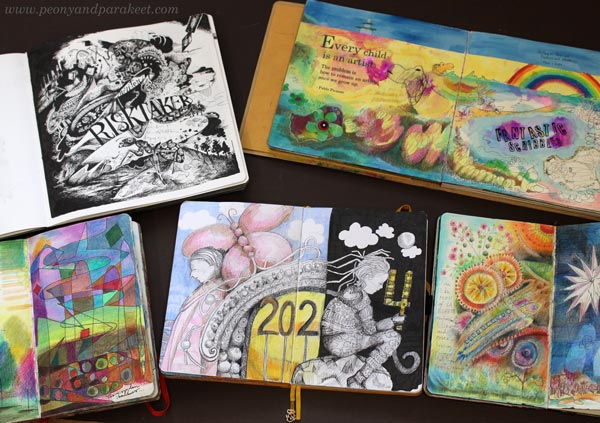
The drawings have no color but they are all full of ideas that still inspire me.
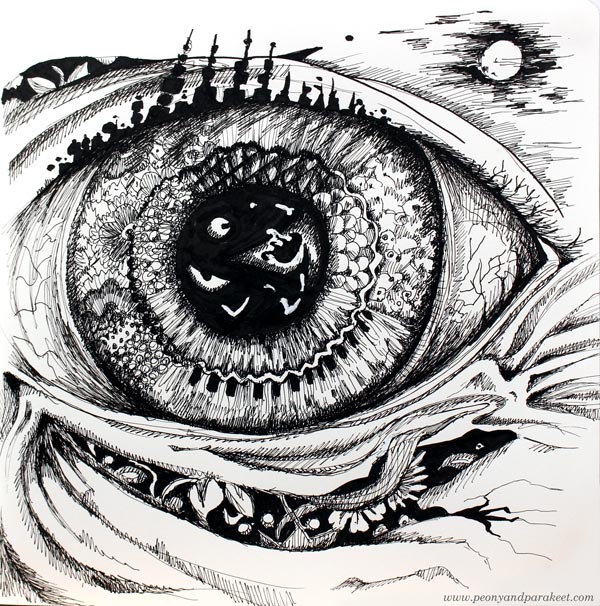
I now want to add ink drawings to my colored pencil journal as well.
Tiny Pages
Last year I bought a very small art journal. This is a pretty cute page!
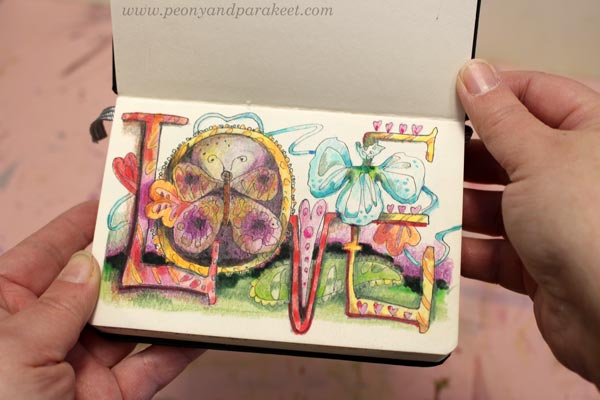
All the reds and pinks looked very nice together.
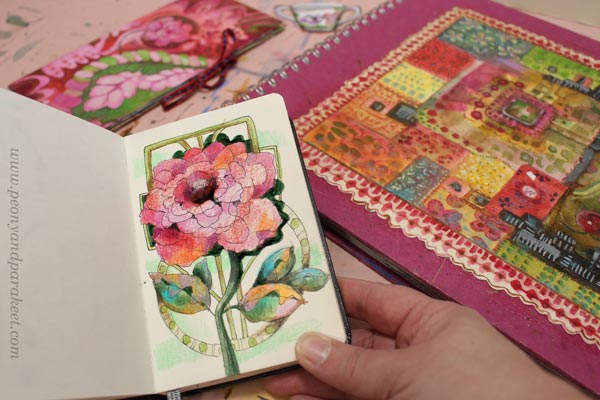
Years go by and my skills grow, but even the clumsiest covers still seem to fit with the new creations.
Doodler’s Resort
While browsing the journals, I found a spread with a transparent film in the middle. I had printed doodles on it and I still quite like the effect. This idea is from 2020, when the world stopped and I couldn’t do anything but mindless doodling.
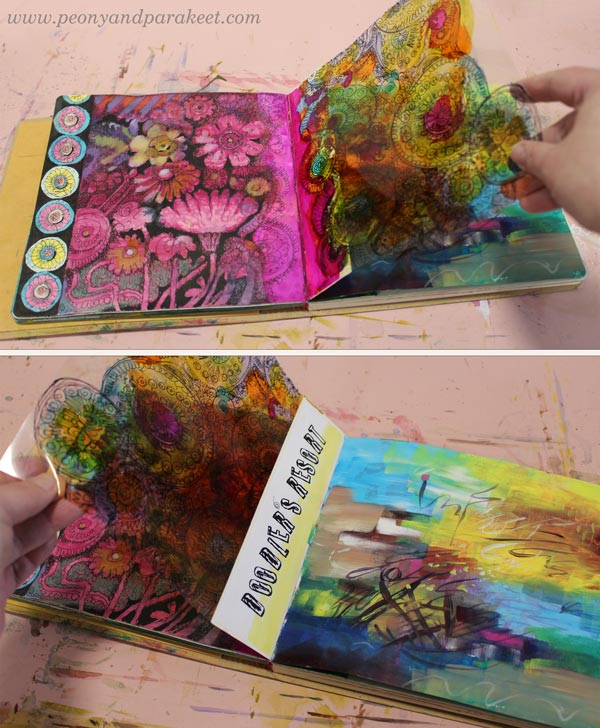
This art journal also has a lovely inside cover.
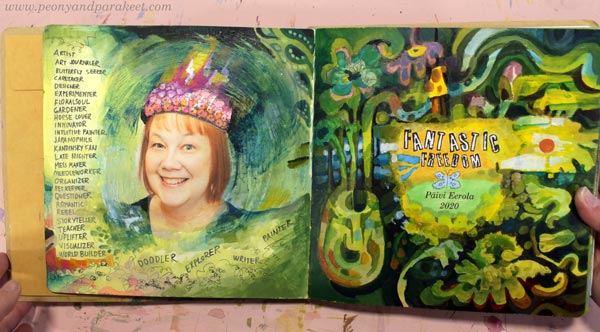
Divide the Content!
I don’t understand why it took so long before I realized that I could add annual pages, inside covers, chapters, and other pages telling about the content of the book in art journals.
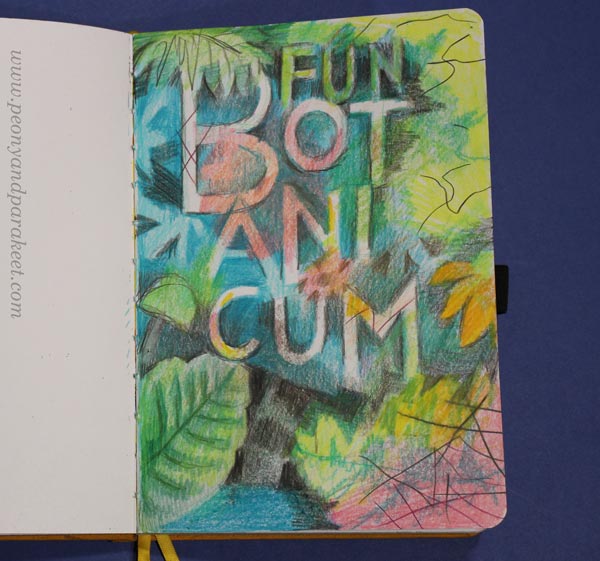
Nowadays, I have a course called Fun Botanicum, where you make a chapter cover, themed pages, and an end page in the middle of an art journal.
Inspiring Art Journals Tell About Time
It was fun to look at old art journals and wonder how these are connected to everything that is going on now.

Time is a mysterious place. It is like an illuminated palace that blinds us. We can only walk away from it to the darkness. But as long as we are alive, we can start the adventure and get creative. “It takes a long time to become young,” said Pablo Picasso.

In my opinion, only by drawing can we know what we really think. The more you draw, the more your skills grow, and the more you will find out!
Do you agree?